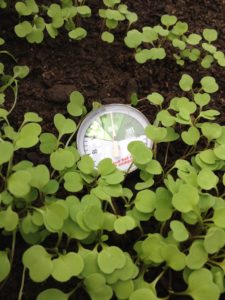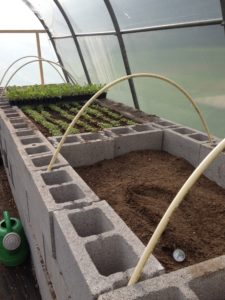Local Compost Materials Heat Community Greenhouse
Jesica Clark of South Pine Street City Farm trials compost substrates to find a sustainable way to heat an urban greenhouse
By Abigail Woughter
From Empty Space to Green Space
When farming a quarter-acre community garden on a city block, it is easy to feel as if everyone is watching. Jesica Clark of South Pine Street City Farm in Kingston, New York had to learn to grow efficiently under the watchful eye of the community.
Having seven years of growing experience on different rural farms, Clark noticed, “I felt a little more pressure in an urban setting when my neighbors were 20 feet away from the garden to make it look as nice as possible. If it didn’t look good, the neighbors would be calling.”
South Pine Street City Farm is located in downtown Kingston, though off a main road on a quiet dead end street. The farm’s plot of land was once just an empty house lot, then a lawn turned community garden, and finally became South Pine Street City Farm in 2011. In addition to growing vegetables on permanent raised beds and operating a farm stand for local consumers, the farm is home to several youth organizations, such as Dig Kids, a program for summer employment that gives students hands-on urban farming experience. Clark and fellow South Pine Street City farmer KayCee Wimbish also support their community by donating one-quarter of the farm’s harvest to local food pantry, Queen’s Galley.
Designing a Compost Heated Greenhouse
When it came time to grow seedlings, Clark drew on her experience and her local farming contacts to rent space in an off-site greenhouse. But small-scale farming had made her especially attuned to sourcing local, and her daily 30-40 minute commute across the county to check on the seedlings made Clark worry about sustainability.
She determined that South Pine Street City Farm needed a greenhouse of its own, but knew the greenhouse site had no source of electricity. The idea for a low-energy-input greenhouse came from a friend who used animal manure from his livestock farm as the composting base to heat his greenhouse.
Composting was no novel concept for South Pine Street City Farm, and Clark wondered if the mixes she used in the garden could be an effective passive heat source in the greenhouse.
“When I was managing the compost at the garden, I sourced coffee grounds from a couple of local cafes in Kingston. I noticed that the coffee grounds were getting up to 125, 130 degrees. So I figured that was probably warm enough to work for a small sized greenhouse.”
Clark received SARE funding to test the performance of three locally sourced compost mixes. The first mix was made up of half coffee grounds, half chipped city mulch, by volume. The second mix was comprised of double the amount of coffee grounds by volume than mulch, and the third mix used a 2:1 ratio of coffee grounds to dry leaves, making it the most finely textured mix of the three.
The compost mixes served as a direct heat source and were located inside the greenhouse. Clark used concrete blocks to form a container that neatly held the compost mixtures. This table-like structure is called a compost bay, and is central to the functionality of the greenhouse.
“The concrete blocks make a nice little heat sink, and they’re sturdy so I’m able to put a frame on top of them for seedlings.”
Extending Fall Production
When Clark began the compost-heated greenhouse project, her main objectives were to grow high-quality seedlings and experiment with extending the Spring and Fall growing seasons in an effort to produce local vegetables longer for her community. “In this whole urban farming movement,” she considered, “I think one thing that has been neglected is the idea of a community greenhouse, especially when it comes to growing in the wintertime and being a resource for different community gardens.”
In terms of South Pine Street City Farm production, the greenhouse helped Clark extend the season of her plants, but not in the way she originally planned.
“What I was thinking when I proposed the project,” she remembered, “was taking plants from the garden and transplanting them to the greenhouse as it started to get colder.”
But there were problems with this approach, mainly the cooling down of the compost mixes, which by late January were maxing out at 105 degrees, instead of the 125-130 degree range she observed in the fall.
“What I ended up doing,” said Clark, “was a lot more direct seeding in the greenhouse. I direct seeded radishes, spinach, and salad greens in the fall.”
Clark was very pleased with the fall season extension of her greens. She continued to experiment with winter production of sunflower sprouts and pea shoots, but the cold temperatures hampered a significant harvest. “It worked,” Clark explained, “there was totally stuff growing there in the winter, but it wasn’t enough production to be anything more than for personal use. It wasn’t really enough to sell.”
This season, South Pine Street City Farm will focus more on direct seeding greens in the fall.
Creating Barriers Against Vandalism
South Pine Street City Farm’s greenhouse is not located on the same dead end lane as the farm but nearby in a field next to the local YMCA, an area of high pedestrian traffic. When deciding between cover materials for the greenhouse, either plastic or the more durable polycarbonate, Clark chose the plastic film for its cost-effectiveness and ease of replacement. Little did she know, replacing it was exactly what she’d be doing. Vandalism became her biggest issue of the season.
“Something about that plastic covering,” she laughed, “must have just said ‘Rip me!’ because I had to repair several holes over the winter time.”
She conceded that this was frustrating, and not in keeping with her thoroughly positive experiences with community members in her time at South Pine Street City Farm. When it comes time for greenhouse renovations, polycarbonate covering will be installed, hopefully deterring any greenhouse vandals.
Producing Food and Possibility
Clark was satisfied to achieve her goals of seedling production and season extension, but the greenhouse also represented community independence and sustainability.
“It was so important,” she assessed, “to be able to have a greenhouse in the city that did not run on fossil fuels and could really be put anywhere.”
In a city, the availability of space is often limited, but Clark insists this should not be a deterrent to projects like the compost-heated greenhouse.
“You just need an open space,” she pointed out. “It could be put in an old parking lot, on a lawn.”
South Pine Street City Farm, itself once just a lawn, speaks to Clark’s ability to work efficiently within the parameters provided. Small-scale farming allows her to more creatively use the resources Kingston has to offer—be it coffee grounds or yard waste—to sustainably serve the community.
To learn more about South Pine Street City farm, visit the website southpinestreetcityfarm.org. To learn more about SARE project FNE12-739, view the summary at sare.org. Click on Project Reports > Search the Database.
South Pine Street City Farm operates in partnership with Binnewater Ice Company, Kingston Land Trust and The Queens Galley.
Abigail Woughter is a junior Agricultural Sciences Major at Cornell University and served as the Cornell Small Farms Program summer intern in 2013.





I read all three documents posted on the SARE site, but none provided the specifics of the bed dimensions, the results of the tested compost, etc. Is there a final report posted with the specifics so that one could attempt to duplicate the results?